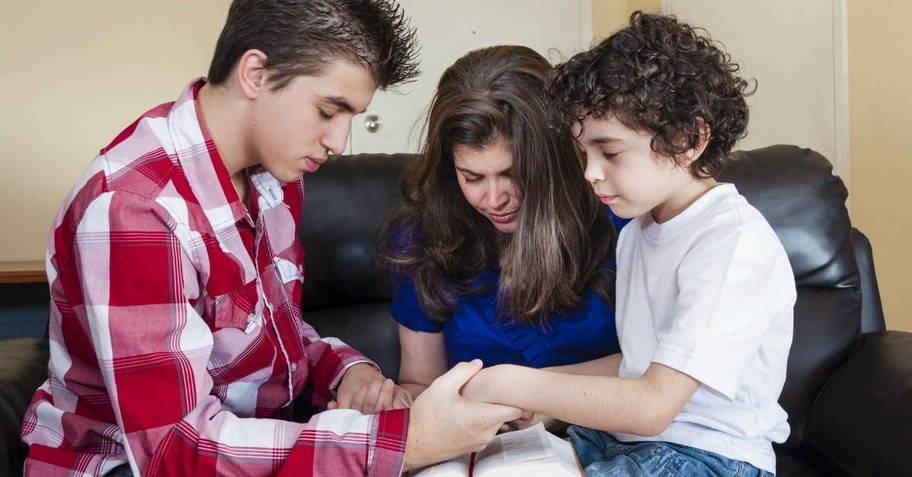9 Ways to Pray as a Family

Make prayer time one of the best times of the day to foster your child’s faith. Praying together equips children spiritually while strengthening family bonds. If we could comprehend, deep down in our spirits, the true power of prayer, we would all pray more - and the difference would radically impact our lives and the lives of everyone around us.
Children like variety, so apply these ideas to add something new to your family prayer life. As prayer becomes an important part of daily life, keep a family prayer journal to record prayer requests and answers. That helps children see God working in your lives. You will be amazed to see the difference consistent family prayer makes in your home.
Here are nine ways to pray as a family:
Photo courtesy: ©Thinkstock/Boonyachoat

1. Dish Up Prayer
To help construct simple sentence prayers, label four bowls “God”, “self”, “actions”, and “needs”. The following are the four categories and examples of words for each bowl:
Names for God: Almighty, Jesus, Savior, Creator
Names for self: Child, friend, your angry or sad child, follower, lamb
Actions related to prayer: praises you for, thanks, needs, asks for help, forgive me, hopes for
Need or blessing: Help, courage, strength, love, goodness, blessing, peace
Let each person take a slip from each bowl and form the words into a short prayer. Or, let each family member take one slip, and as a family put the words together to form a simple prayer. This combines learning and play.
Photo courtesy: ©Thinkstock/freedom007

2. Pray with Sign Props
Use the acrostic ACTS to pray and teach about prayer. Make a sign for each letter and what it represents (A-adoration, C-confession, T-thanksgiving, S-supplication). On each sign around the main word, in smaller letters, write words and phrases that reflect the meanings. Here are some examples:
Adoration: you are almighty, everlasting is your love, Father of mercy
Confession: lied, spoke hurtful words, disobeyed, hurt someone
Thanksgiving: home, family, friends, good test score, food, great day, good weather
Supplication: help me be kind, heal my friend, give me hope
Lift one sign at a time and let each family member pray that element. They may read a phrase from the sign or make one up. Repeat with each sign. Be sensitive to confession, and let people say, “I am sorry for my sins.” Then allow a moment of silence for individuals to tell God their sins.
Props provide visual cues and encourage children to talk to God.
Photo courtesy: ©Thinkstock/Sasiistock

3. Circle Up for a Pow-Wow
Sit in a circle. Ask each person to name one “wow” (positive blessing) and one “pow” (prayer need). Let the next person pray one sentence for the blessing and one sentence for the need. Continue on to the next person until everyone shares and prays. I created this when my children were young and it became a family favorite. I recall my older daughter giving her brother Michael her lunch snack the next day and saying, that’s for after your test. I’m praying that you do well. That was your “pow” last night. They all took a more active interest in one another with this type of prayer.
When we pray for someone else, we tend to care more about his or her joys and sorrows and want to cheer them on over the problems. Ask family members to continue praying for that person until the next pow-wow.
Photo courtesy: ©Thinkstock/KatarzynaBialasiewicz

4. Echo Prayers
Echoing a phrase from a psalm or Bible passage uses Scripture to pray. Let one person be the reader to read a psalm or passage. After each verse, have the person state a phrase from the passage and let everyone echo that phrase.
For example, Read Psalm 23 and repeat the phrase, “The Lord is my Shepherd.”
The echo, or refrain, allows everyone to participate and emphasizes one important concept. Children may remember the words over the coming days.
Follow the prayer with a chat that can also be more prayer. For example, use Psalm 136 about God’s loving kindness for the echo prayer. Then add your own reasons to praise God’s loving kindness to your family.
Photo courtesy: ©Thinkstock/B-C-Designs

5. Prayer Walk
Walk around your neighborhood, church, school, or other area and pray as you walk. Pray before you start and chat a little about where what you’d like to pray about as you walk. Stop every little distance and let one family member say a short prayer to bless the people who live or visit there. If you meet someone on the walk, ask if they would like you to pray for them for any need or blessing. Use your senses to notice animal sounds, shouting, needs like a messy yard, and other signs of prayer needs.
We sometimes started by walking around out house and praying for God to bless our guests, our home, and us. We asked God to guard our hearts and help us use our home for His purposes.
This adds movement to prayer and helps children focus on other people.
Photo courtesy: ©Thinkstock/monkeybusinessimages

6. Prayer Wall or Board
Transform a wall into a prayer center. Hang a bulletin board on a wall or use thumbtacks and sticky notes to attach pictures and notes to a wall. Put up photos of people to pray for with a note about specific needs. Add pictures of reasons to thank God, such as creation and recent blessings.
Stand by the wall and pray over each picture and note. Add a sticker or note when God answers a prayer.
This is a great way to introduce little ones to prayer. You can hold your child up and say a few words about the person he or she points to and then say a prayer. They get to know important people in their lives and hear you pray. My little ones often clapped after each prayer and always kissed the photo of their dad when he was away on military orders.
Photo courtesy: ©Thinkstock/Jacob Ammentorp Lund

7. Prayer Blocks
Children like to play with blocks, so add an element of prayer for them.
When our sons were young, my husband cut a one by one board into one-inch blocks and sanded them. We wrote words on the sides of the blocks and let our boys add stickers. Then we used a child-safe varnish to coat them. At prayer time, we got out the blocks and let our sons point to a picture or hold one up and said a short prayer related to the word or picture.
For older children, buy photo blocks to fill in the sides with words and photos. Toss the block and let the catcher looked at the side up and say a prayer.
Photo courtesy: ©Thinkstock/Sasiistock

8. ABCs of Prayer
Use the alphabet as reminders of what to pray. You can choose one letter a day or draw the letters out of a container and do several in a day. For example:
- Adore God
- Believe in God’s abilities
- Confess your sins
- Delight in God’s creation
- Express your feelings
- Forgive anyone who hurt you
- Give thanks
- Humor God by sharing funny moments
- Invite the Holy Spirit to guide you
- Journal
- Keep knocking (asking)
- Listen or love
- Mean what you say
- Notice blessings and thank God for them
- Offer your talents to God
- Praise the Lord
- Quietly listen to God
- Recite a Scripture as a prayer
- Seek help for others
- Trust God
- Unite your will to God’s (let him change your heart)
- Value God
- Worship God
- X-ray listen
- Yearn to learn from God
- Zealously end with the desire to return (say we’ll talk again)
Photo courtesy: ©Thinkstock/yelo34

9. In the Moment Prayers
Be ready to stop and pray as needs arise. You could designate a room or space as the Prayer War Room where anyone can call the family to gather to pray. Ask the person who called for prayer to state the need; then hold hands and pray. Each person can speak up or squeeze the hand of the next person if they prefer to pray silently.
These can include routine and spontaneous prayers. Pray with your children before they leave the house or in the car before you drive off. Pray at meals and bedtime. Pray when you hear bad news or a siren. Pray when you hear good news too.
As you make family payer a habit it will become part of the fabric of your life, woven into the day to keep you connected to God and one another.
Karen Whiting is an author of 25 books, an international speaker, and former television host. She’s a mother of five and a grandmother. Her book 52 Devotions for Busy Families makes it easy to practice faith at home. Connect with her on Facebook, Twitter, and Pinterest.
Photo courtesy: ©Thinkstock/SARINYAPINNGAM
Originally published April 08, 2019.








